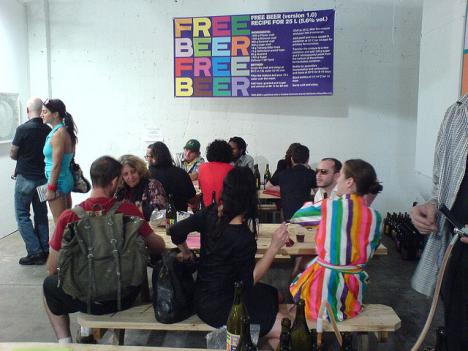WHEN ART SPREADS
SuperflexINTRO
Free Beer is a work of art, a recipe and a product. The project started in 2004 as Our Beer when the Superflex group of artists were guest instructors at IT University. Among other things, Superflex conducted a series of seminars on copying and copyright – topics that the group investigates in many of its artistic projects. As an extension of the seminars, Superflex gave the students a specific two-part assignment:
1. Participate in the development of a non-digital product based on open source methods.
2. Design a product “brand” that creates a connection to similar products and at the same time distinguishes itself from them.
The project proposal includes the statement “the project also takes into account the political and philosophical dimensions of the copyright issue”. There are thus many things at stake in the project, ranging from design, marketing, product development, the open source philosophy and the discussion of copyright more generally. At the same time, the entire project was part of Superflex’s work and thus also part of an artistic practice – even though art may not be the first thing you think of when you hear about IT and beer.
When beer is not just beer
The Free Beer project uses the principle of open source and free software and transfers it to a product from the “real world”. According to the concepts of open source and free software, the programmed code for a piece of software is visible to everyone. The recipe for beer and the graphic elements of design labels and so on are issued under a “creative commons” license (Attribution-ShareAlike 2.5), which means that both are made available to everyone. Everyone has the right to use and change the recipe and to make money from the beer.
But what makes a beer a work of art? The question of the boundary between art and “non-art” arises frequently in connection with Superflex’s projects. The same applies to other artists who work with art as intervention and ideas. In this type of artwork, art changes from being an (aesthetic) object created by one artist to being a project with multiple participants in which the artists act more like project managers. The projects often take place in collaboration with others who are specialists in the field that the artists wish to investigate with the project.
 Free Beer at Art Basel, Miami i 2006. Photo: Superflex
Free Beer at Art Basel, Miami i 2006. Photo: Superflex
In this way, art spreads to additional locations. It draws directly on some of the (invisible) structures that make up our world – and our daily life. Everything that is in play when we buy a product in a supermarket or go online. At the same time, their projects also take place in the museum and in the art world, where posters and objects are both works in themselves and also references to all the other places where the work also takes place.
FACTS
Superflex is a group of artists consisting of Bjørnstjerne Christiansen (1969, DK), Jacob Fenger (1968, DK) and Rasmus Nielsen (1969, DK). They attended the Royal Danish Academy of Fine Arts together and founded Superflex in 1993. Superflex describes their projects as “Tools”, and on their website they describe this as “a model or a proposal that can be actively used and modified by the user”. They are thus not works of art in the traditional sense when the name Superflex appears on them. Superflex’s projects and their practice are often described as interventions or social art.
Their first major project, Supergas / Biogas in Africa, which started in 1996, entailed creating a biogas plant for poor areas in Africa to generate energy from waste products. As in many of their projects, Superflex was dependent on collaboration with people other from disciplines, in this case engineers. In later projects, they have worked further in the same direction – across art, activism, entrepreneurship and product design. It is thus not craft that is the raw material for Superflex, but rather their ideas. As artists, their primary tools are collaborational skills and project management skills.
Besides Free Beer, Superflex is represented in Louisiana by the works Flooded McDonalds from 2008 and posters that refer to the Biogas in Africa project from 1997.











